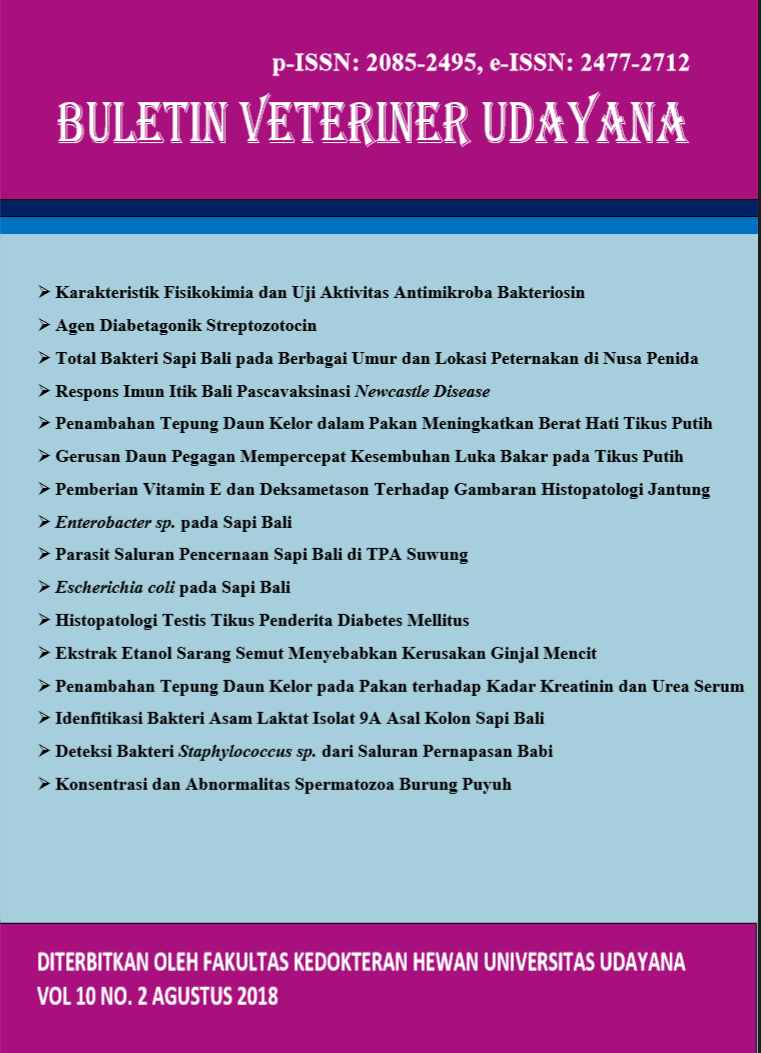ETHANOL EXTRACT OF MYRMECODIA PENDANS CAUSED HISTOLOGICAL STRUCTURE DAMAGE OF MICE KIDNEY
Abstract
Chemical analysis of the ant-plant (Myrmecodia pendans) showed that plants have various chemical compounds of flavonoids, tannins, tocopherols, multimineral and polysaccharides. The aim of this study was to find out the effect of ethanolic extract of ant-plant on histopathological changes in male mice (Mus musculus) kidney. Twenty four clinically healthy mice at aged 10-12 with weight 25 to 35 g were obtained for this study. The sample were divided into four groups randomly, each treatment group consisted of six mice. Group P0 is the negative control group were given standard feed and drink, P1 is a group were given standard feed and ethanol extracts ant plant with a dose of 100 mg/kg body weight, P2 is a group were given standard feed and ethanol extracts ant plant with a dose of 200 mg/kg of body weight, P3 is a group were given standard feed and ethanol extracts ant plant with a dose of 300 mg/kg. After completion of the treatment on the day, the kidney was taken for histological preparations were made and stained with the hematoxylin-eosin method. The variables examined were haemorrhage, degeneration and necrosis in the renal proximal tubules. The Kruskal-Wallis test results showed that ethanol extract of ant-plant had a significant effect (P?0.05) on the incidence of hemorrhage in the renal tubules. Based on these results it can be concluded that the ethanol extract of ant-plant with a dose of 300 mg/kg body weight can cause kidney histopathological changes such as hemorrhage, degeneration, and necrosis.
Downloads
References
Ajila CM, Rao LJ, Rao UJ. 2010. Characterization of bioactive compounds from raw and rip Mangifera indica L. peel extracts. Food Chem. Toxic. 48:3406–3411.
Alam S, Waluyo S. 2006. Sarang Semut Primadona Baru dari Papua. Majalah Nirmala. PT Gramedia. Pustaka Utama. Jakarta.
Beecher GR. 2003. Overview of dietary flavonoids: nomenclature, occurrence and intake. J. Nutr. 133:3248S-3254S.
Davide B, Ersilia B, Corrado C, Ugo L, Giuseppe G. 2011. Distribution of C- and O-glycosyl flavonoids (3-hydroxy-3methylglutaryl)glycosyl flavanones and furocoumarins in Citrus aurantium L. juice. Food Chem. 124: 576–582.
Guyton AC, Hall JE. 1997. Ginjal dan Cairan Tubuh. In: Setiawan I, Editor. Buku Ajar Fisiologi Kedokteran. 9th ed. Jakarta: EGC; Pp. 375-437.
Harun N, Syari W. 2002. Aktivitas antioksidan ekstrak daun dewa dalam menghambat sifat hepatotoksik halotan dengan dosis sub anastesi pada mencit. J. Sains Teknol. Farm.7(2): 63-70.
Katzung BG. 2001. Farmakologi Dasar dan Klinik. Vol. 1. Jakarta: EGC.
Khanbabae K, Van RT. 2001. Tannins: Classification and Definition. Nat. Prod. Rep. 18: 641-49.
Kiernan JA. 1990. Histological dan Histochemical Methods: Theory and Practice. 2nd Ed. Pergamon Press. Pp. 330-354.
Leong CN, Tako M, Hanashiro I, Tamaki H. 2008. Antioxidant flavonoid glycosides from the leaves of Ficus pumila L. Food Chem. 109(2): 415-420.
Lu FC. 1991. Basic Toxicology: Fundamentals, Target Organs, and Risks Assements, diterjemahkan oleh Edi Nugroho, 47, Hemisphere Publishing Corporation, Washington DC.
Manna P, Sinha M, Edward PC. 2009. Protective Role of Arjunolic Acid in Response to Streptozotocin Induced Type-I Diabetes via Mitochondrial Dependent and Independent Pathways. Toxicol. 257: 53-56.
Merken HM dan Beecher GR. 2000. Liquid chromatographic method for the separation and quantification of prominent flavonoid aglycones. J. Chromatography. 897: 177–184.
Nabib R. 1987. Patologi Khusus Veteriner. Edisi 2 Proyek Peningkatan Pengembangan Perguruan Tinggi. IPB.
Resang AA. 1984. Patologi Khusus Veteriner. 2nd Ed. Percetakan Denpasar. Pp. 25-248.
Silalahi J. 2002. Senyawa polifenol sebagai komponen aktif yang berkhasiat dalam teh. Majalah Kedokteran Indonesia. 52(10): 361-4.
Simanjuntak F dan Subroto MA. 2010. Isolasi Senyawa Aktif dari Ekstrak Hipokotil Sarang Semut (Myrmecodia pendens Merr. dan Perry) sebagai Penghambat Xantin oksidase. J. Ilmu Kefarmasian Indonesia. 8(1): 49-54.
Subroto MA, Saputro H. 2006. Gempur Penyakit dengan Sarang Semut. Penebar Swaday, Jakarta. Pp. 21-28.
Syahnur SR. 2011. Isolasi dan Karakterisasi Triterpenoid dari Tumbuhan Sarang Semut. Skripsi. Universitas Andalas. Padang.
Tian XJ, Yang XW, Yang X, Wang K. 2009. Studies of intestinal permeability of 36 flavonoids using Caco-2 cell monolayer model. Int. J. Pharm. 367: 58–64.





